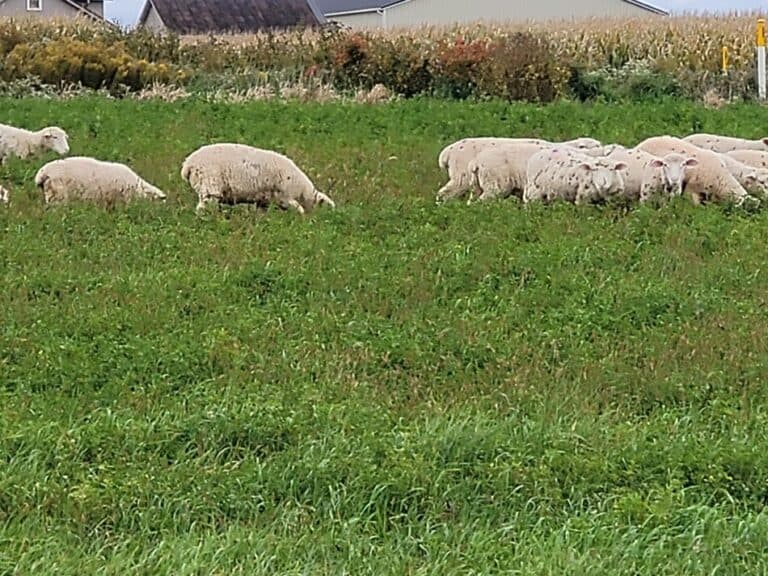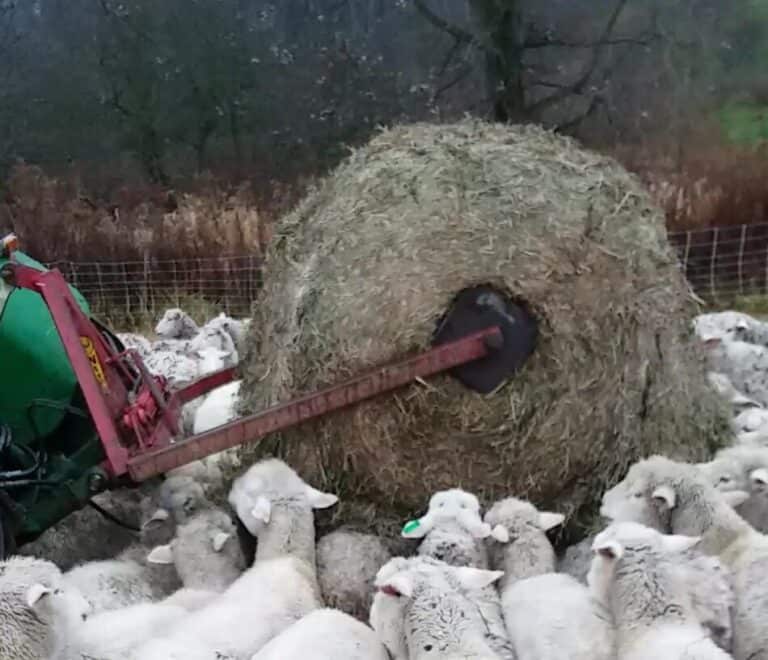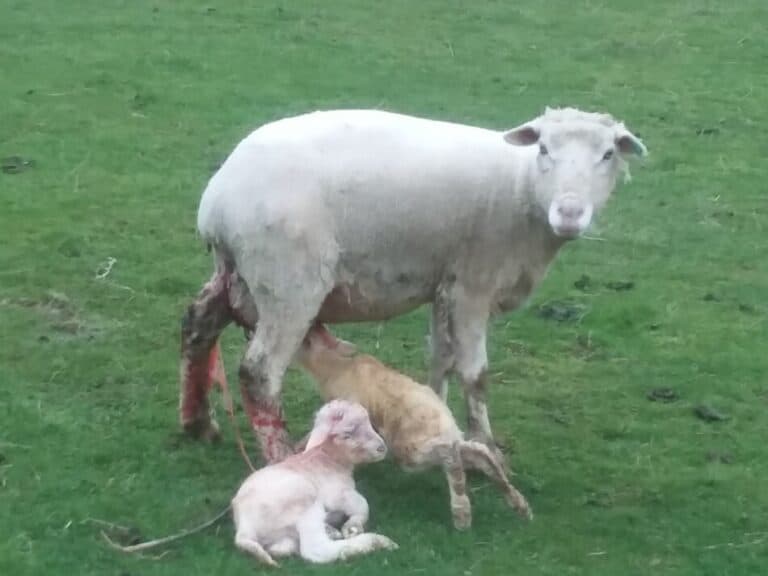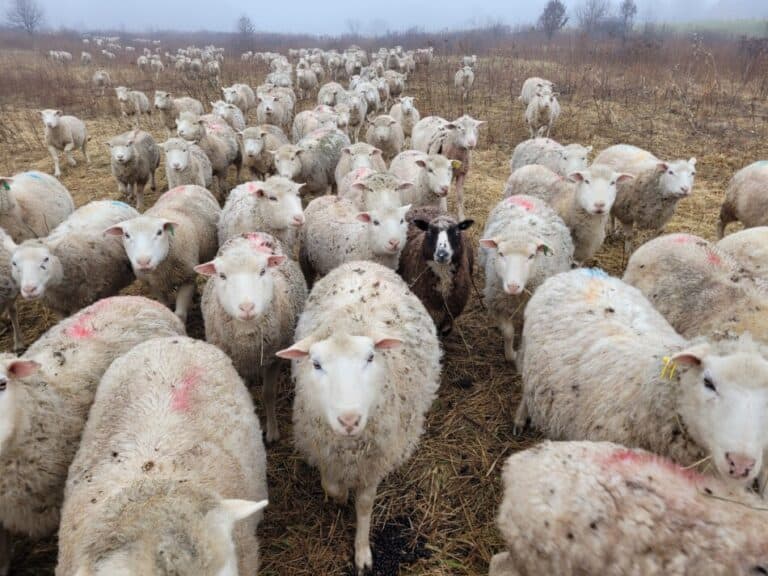Are All Sheep White? Insights From A Shepherd
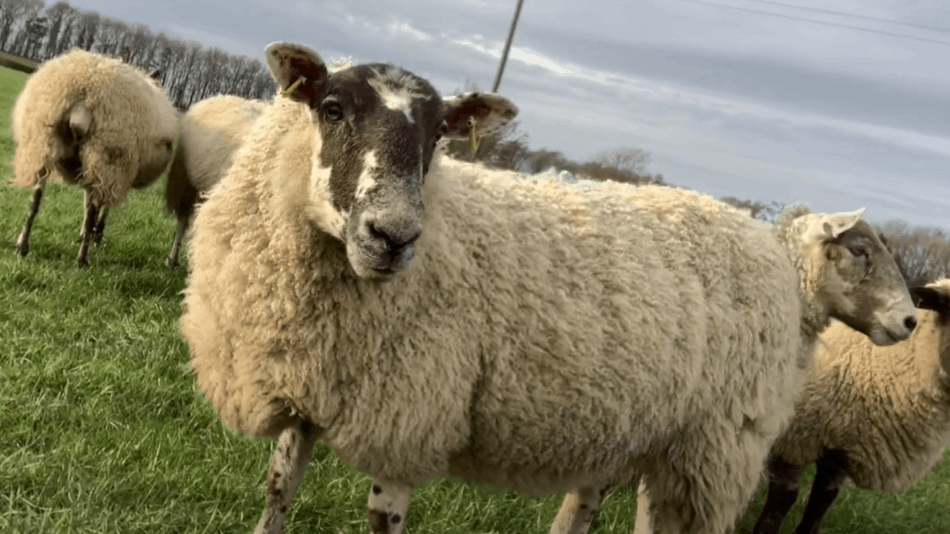
Flocks white sheep are a common site in some parts of the country, at least that’s what it looks like when you drive by a flock or see an interesting video. Are white sheep just the most common or are all sheep white?
While certain sheep breeds have a variety of fleece colors, the most common wool color for the vast majority of sheep being raised today is white, simply because white wool has more dyeing options.
We raise sheep for a living, our flock is white, crossbred ewes that are mostly Dorset and Polypay based, yet, we have a black ewe. Just one. Let’s talk about it.
Read 8 Things You Should Not Do Around Sheep for more information on sheep behaviors and the things you should avoid doing when around sheep.
Most sheep are white
Most sheep in the world have white wool. White sheep commonly are white over their entire body, like Merino sheep, yet some sheep have dark hair on their head and legs, yet still have white wool, like the sheep pictured above.
The reason most sheep are white is that white is the dominant color in sheep and white wool has been selected for by the farmers and ranchers.
White wool has more color options for the buyer
White wool is more dyeable, so the buyer or user of the wool has more options of what to do with the wool after purchasing it.
Think about it like paper, if your paper were dark brown or black you would have a very limited color range for your pen, markers or crayons. Whereas with white paper, you can use any color pen or marker you want and it will show up.
There are differences in white wools as far as what you can use the wool for and which ones dye well, but generally speaking white wool gives you more options.
Naturally colored wools have limited coloring options
Some crafters enjoy overdyeing a dark wool with a color like red, which will give red hints to the wool, sort of like putting red hints of color in your hair, but as you can guess your color options are limited.
As far as what you make with the wool, as long as a white and a black (more commonly called natural colored, since it’s not a true black) wool have the same properties they can be used for the same purposes.
Genetics determine the color of the sheep wool
Genetics determined the color of the sheep’s wool, the same way that genetics determined your eye color.
Some colors are dominant, meaning that color takes over any other color. In sheep, the dominant color is white. It’s always seems odd to me that white is dominant, but as far as wool color goes, that’s the case.
For sheep, where white is dominant, it is harder to get colored wool to show up in the flock if you start with all white animals.
It can be done of course, how long it will take and what breeds you’ll need to use to make it happen will depend upon what breed you started with, but it’s doable in two to three generations.
In sheep, colored wool is recessive, white is dominant
In sheep, colors are recessive, meaning this color is harder to get to show up in the sheep’s wool, even though it may have some of the genetics for the color. This is why a black sheep can have white lambs, colored wool is recessive.
Here is a simple look at the genetics of white versus colored sheep with “W” being dominant and “w” being recessive:
- WW =white sheep, this is a homozygous white sheep. The sheep is white and all of it’s lambs will be white (same for both males and females).
- Ww =white sheep, this is a heterozygous white sheep, meaning it looks white (since white is dominant in sheep) but it is actually half white, half colored.
- ww =colored sheep, this is a homozygous colored sheep, which is the recessive wool color in sheep. This sheep will not have white wool. The color of the wool will depend on the color of the parents. A black sheep is ww.
For more details on sheep color genetics, read Basic Sheep Genetics by Debra K. Aaron, University of Kentucky.
Both black sheep and white sheep can be the same breed
Some breeds of sheep come in multiple wool colors, some have spots and some breeds only come in one color, it all depends upon the breed.
For instance their are natural colored Border Leicesters and white Border Leicesters. They are sheep from the same breed, yet some are white and some are colored anywhere from light grey to nearly black.
Many breeds have both white and colored sheep, including Romney, Finn, Shetland, Icelandic, Merino, for a few common examples.
Most sheep breeders tend to prefer to have their sheep be the traditional breed color, which for most breeds is all white, unless they are involved in craft shows or specialty wool sales, for which colored fleeces would make sense.
Fleece color is independent of the sex of the sheep
Fleece color is independent of sex or age of the sheep, colored wool can be on rams or ewes, just like white wool can be on rams or ewes.
Fleece color may fade as the wool grows, the ends bleach in the sun, but a colored sheep will have naturally colored wool it’s entire life. Just like a white sheep will have white wool it’s entire life.
A ewe can give birth to black lambs with white lambs
One of our ewes last year had a set of triplets that were two black lambs and one white lamb. This is not very common for us, since we use white rams, but depending upon the genetics neat colors occasionally pop up.
If we wanted more naturally colored lambs, we would need to start using naturally colored rams.
A black ewe can have white lambs
We have one black ewe in the main flock this year who has a single white lamb, which looks the same as her baby last year.
It’s funny that she is such an easy to spot sheep in the flock, yet her baby looks a lot like everyone else’s lamb out there!
If this ewe was bred to a naturally colored ram, she would have naturally colored lambs, every time since both she and the ram are naturally colored, themselves. If we keep using white rams, she’ll keep having white lambs.
Sheep can be colors other than black or white
Sheep come in a huge variety of colors, once you start looking at the breeds that are selecting for naturally colored wool.
A great example of this is with the Shetland breed. Shetland sheep have all manner of colors in the breed, with greys, reds, some lightly colored fleeces and some richly colored fleeces.
Shetland Colors is a listing of all of the colors Shetland sheep according to the breed registry. If you looked up Shetlands and found more color variety that these, look under markings to see more fleece colorations.
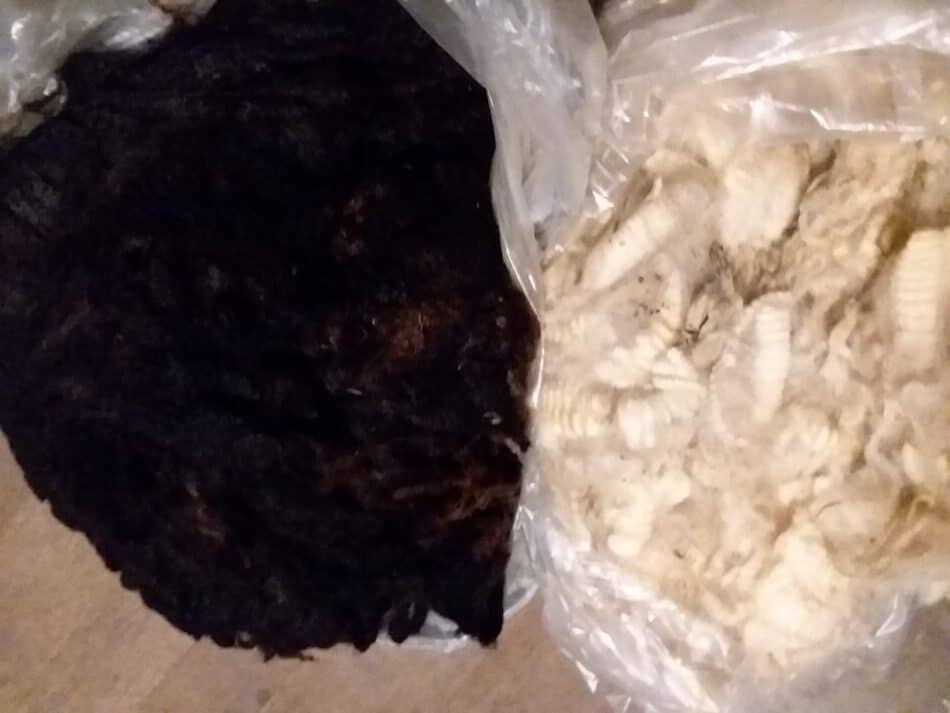
Black and other colored wools are very popular now
Naturally colored wool is very popular now with hand spinners and other crafters. Some farms sell fleeces for over $100 each and those fleeces sell out months in advance!
Look up natural colored wool on Etsy and see all of the choices of wool you can buy, be sure to note the price. It’s significantly higher than that of commercial white wool.
Craft wool with great properties, like fineness or spinability, or a beautiful or unusual color, sells really well to interested buyers.
There are also Fiber Festivals and Sheep and Wool Shows are popular attractions where crafty people go to find new fleeces for this year’s spinning or felting projects. Stop in and attend, you’ll be shocked at how popular this stuff is.
Best Breeds Of Sheep For Wool gives you my top picks for wool sheep.
100+ Breeds Of Sheep And Their Wool is a huge chart showing wool and it’s uses under each breed of sheep!
Photo credit: The Sheep Game (YouTube) the speckled faced ewe pictured at the beginning of the article and in the featured image
